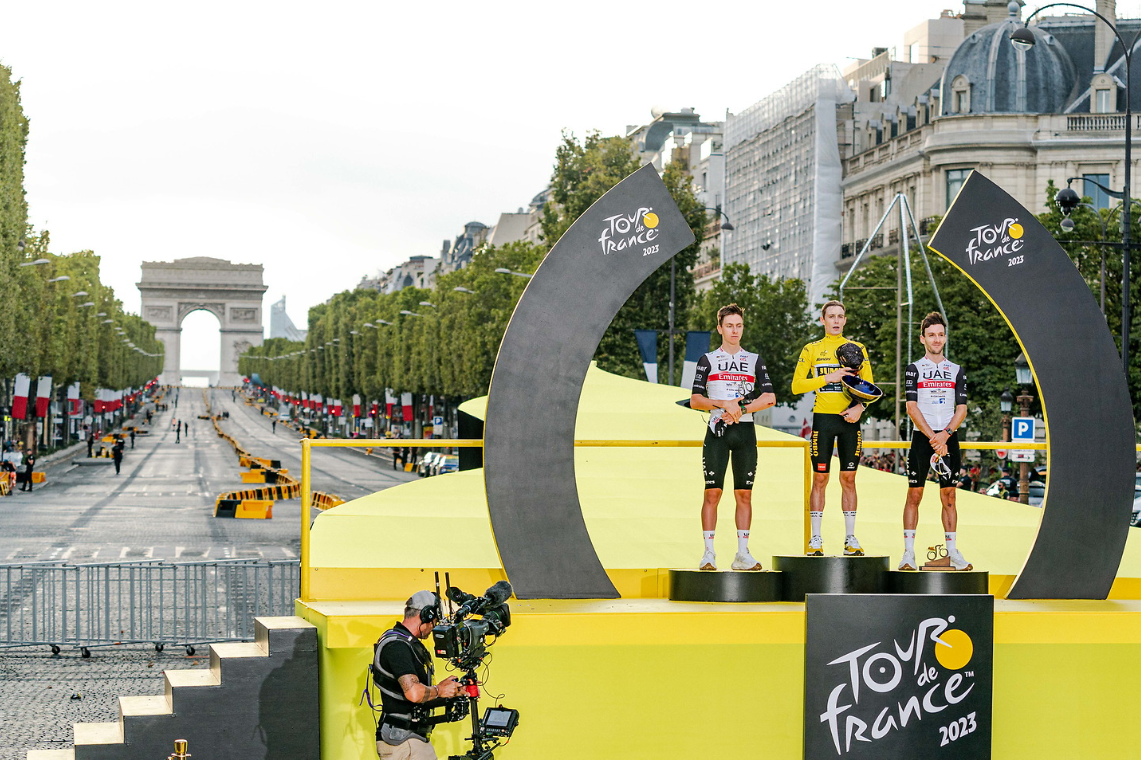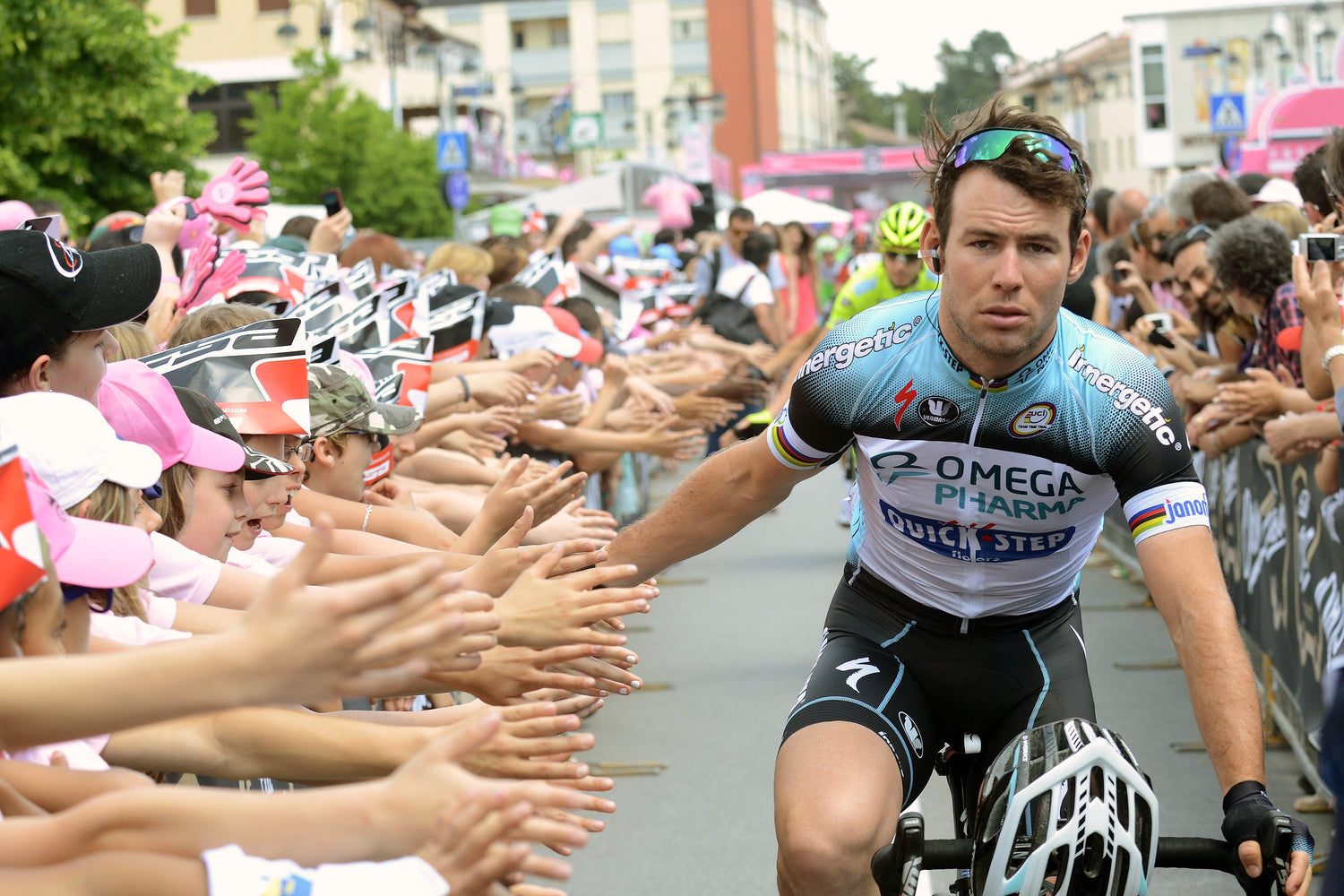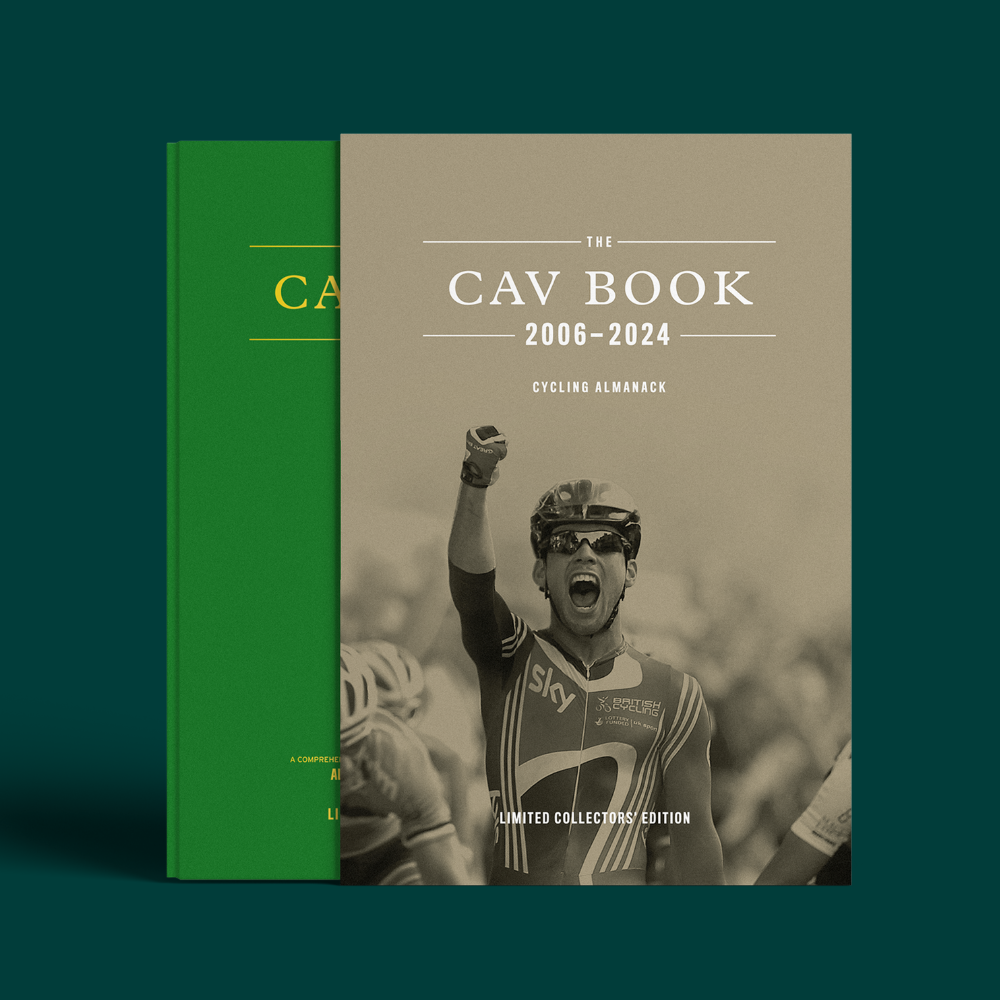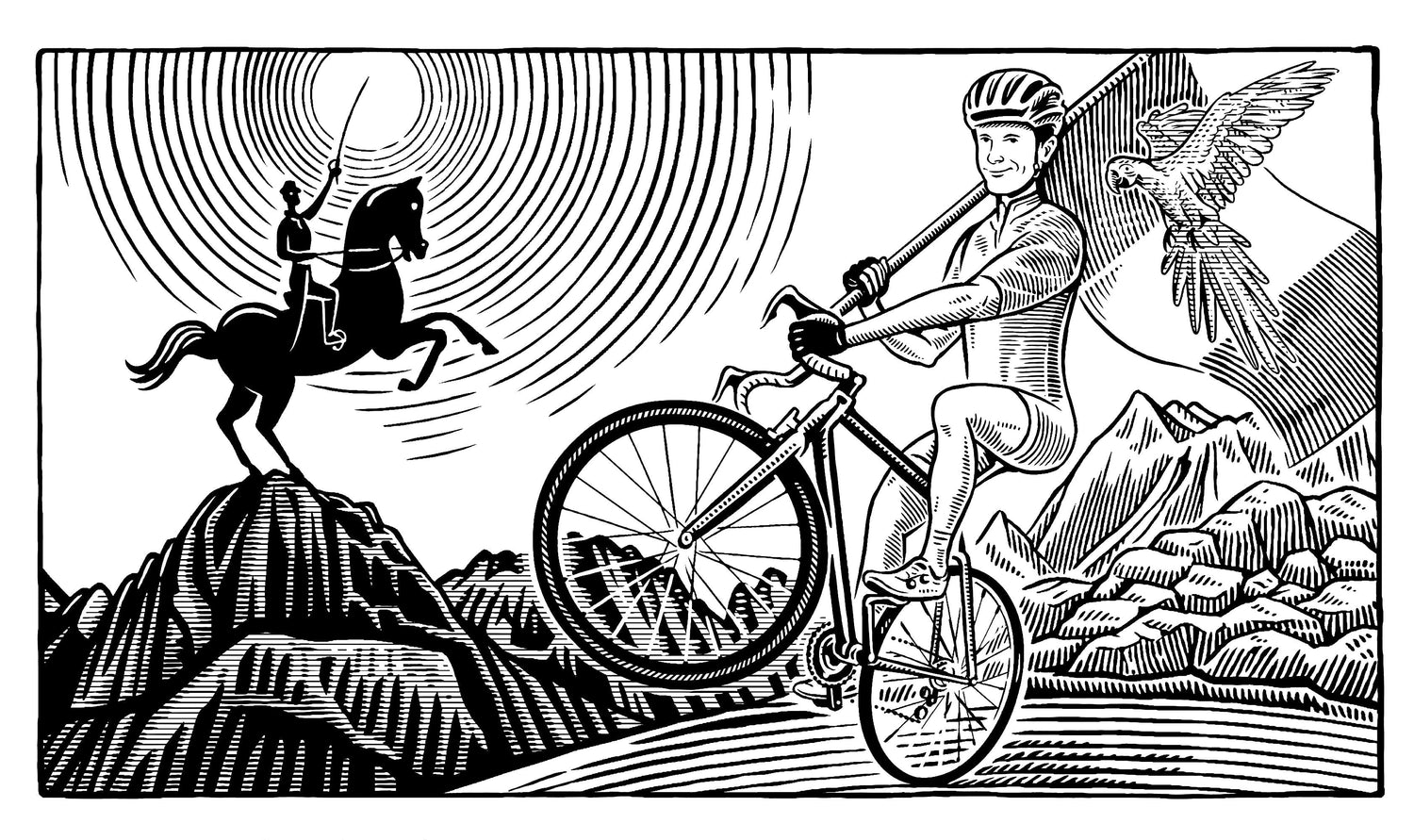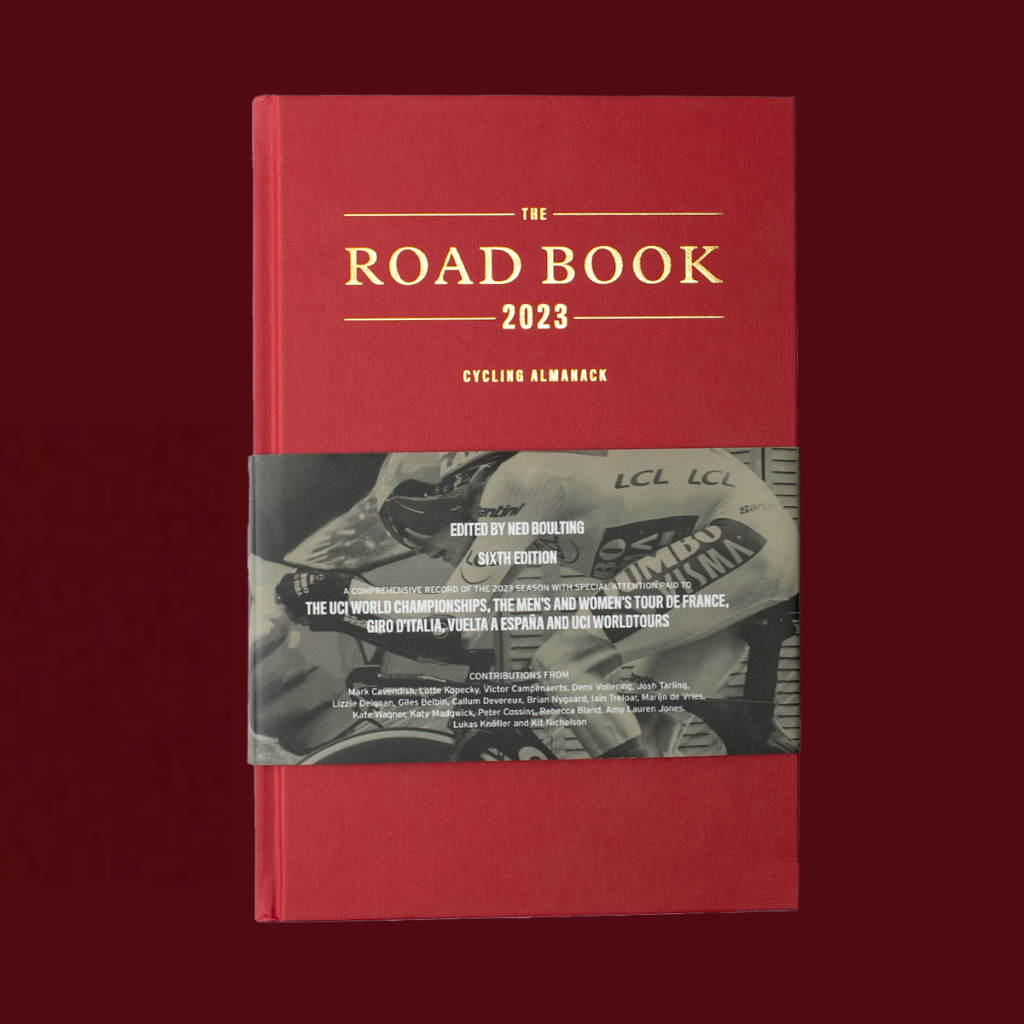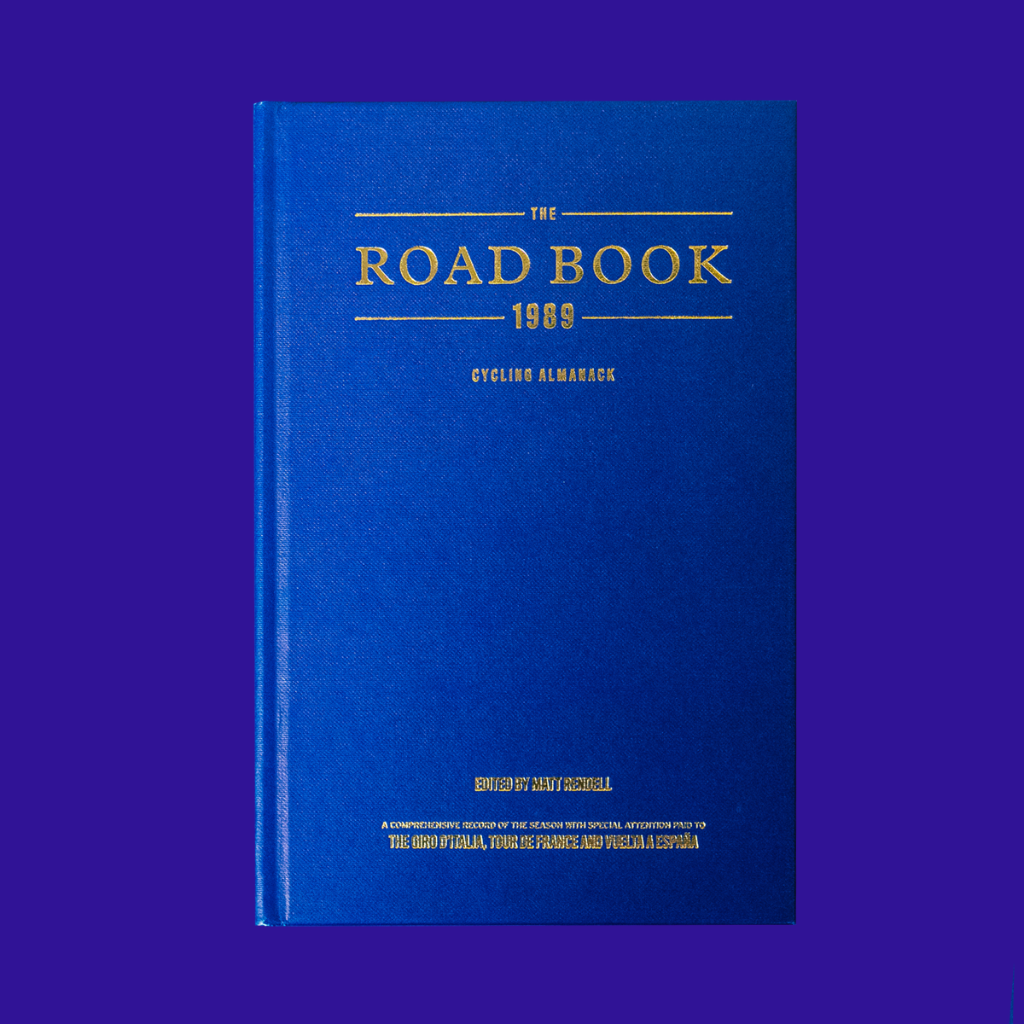We are just a couple of days away from the Grand Départ of the 111th edition of the Tour de France, and before the peloton rolls out along the streets of Florence, we thought we’d whet your appetite with a couple of previews!
We’ll break down each stage here, which days look set to trigger big battles for the Yellow Jersey and the general classification, and on which days Mark Cavendish will be looking to take a sprint victory for his record breaking 35th stage win.
The most famous of bike races starts in Italy for the first time in its history, and for a further first, having been displaced from the Champs Elysée due to the Olympics, the Tour will instead slam to a halt in Nice. From Tuscany to the French Riviera, we are at least guaranteed some spectacular views as the riders duke it out across some Europe’s most gorgeous landscapes.
There will be much more than just aesthetically pleasing terrain to keep fans interested though, with 7 mountain stages, 4 summit finishes, 52,230m of vertical gain, 8 sprint stages (probably) and a final day individual time trial for the first time since 1989 (more on that later) it’s a route which should encourage an absolute belter of a race to celebrate 120 years of the Tour de France.
Here is what the 184 riders will be facing.

Stage 1 – Florence – Rimini 206km 29th June
The race’s opening stage is a doozy, its being billed in some quarters as possibly the toughest opening stage in the history of the race. In terms of excitement, it has big boots to fill, and it’ll be tough to top the inter-Yates brothers battle from Bilbao last year.
Having said that, the organisers may have managed exactly that with a punchy parcours featuring seven category 2 and 3 climbs spread throughout the day before a flat final 27km. The triple punch of the Côte de San Leo (4.6km at 7.7%), Côte de Monternaggio (4.2km at 6.6%) and the Côte de San Marino (7.1km at 4.8%) form a particularly tasty section between the 150km and 180km marks and we think this is where the real action of the day will come.
The parcours is suited to a puncheur to win from a breakaway, especially the likes of Mathieu van der Poel (Alpecin-Deceuninck) or Wout van Aert (Team Visma-Lease a bike) who excel in the hilly spring classics, and we wouldn’t be surprised to see one of them take an early victory from a small bunch. Positioning over the crest of the final climb (as the race enters San Marino – the 13th country it has visited) will be vital, if a small group can get a gap there, they may well be capable of staving off the chasing peloton to the finish line.
20 years ago, the last man to complete the Giro-Tour double passed away in Rimini. Given that Tadej Pogačar (UAE Team Emirates) is attempting to repeat this feat for the first time since 1998, and if the way he rode the Giro d’Italia is anything to go by, the Slovenian could be looking for a statement win on the opening day so expect him to be in the mixer at the sharp end of the race on terrain suited to his aggressive style.

Stage 2 – Cesenatico (Marco Pantani’s hometown) – Bologne 199.2km 30th June
Stage 2 is considerably flatter with a few small lumps, the most significant of which is probably the Côte de San Luca which features twice towards the tail end of the stage. Its only 265m high and 1.9km long, but the 10.6% average gradient makes for a tough prospect. Again, van der Poel will fancy his chances to punch on this climb, and it will certainly result in breakaways going for a stage win. Another day for the punchy climbers and breakaway merchants, they’ll be looking to emulate the sadly absent Julian Alaphilippe’s swashbuckling style on the roads on which he won the World Championships in 2020.

Stage 3 – Plaisance – Turin 230.8km 1st July
Three days of lumpy, exciting racing and we get the first sprinter's stage, and the longest day of the tour. With a few category 4 bumps early on, some riders will go up the road but with the likes of Mark Cavendish (Astana-Qazaqstan), Jasper Philipsen (Alpecin-Deceuninck), Fabio Jakobsen (DSM-Firmenich PostNL) and Mads Pedersen (Lidl-Trek) in the bunch, they will not be allowed to get too far.
The contest for the Green Jersey will burst into life here, but the real point of interest will be the attitude of Astana Qazaqstan and Mark Cavendish. With 8 stages to pick from to bring him that final, 35th stage win, will the Manx Missile target a day which suits him best and go all out for the win there, racing cautiously otherwise, or will he batter at the door on every stage, bludgeoning his way to becoming the greatest ever stage winner at the Tour de France?

Stage 4 – Pinerolo – Valloire 139.6km 2nd July
They’ve let the sprinters have some fun, now its time for a very early GC clash as we cross the Alps in the opposite direction to Napoleon and Hannibal Barca for the race’s first mountain stage and it’s a big one.
It’s a shorter stage than those preceding it, and with a 19km descent to the finish its unlikely to be decisive for the GC contenders. Though having said that, those competing will be looking to take any time they possibly can and with the legendary climb up the Col du Galibier featuring, there will be gaps that can be exploited. Tom Pidcock (INEOS Grenadiers) and Matej Mohorič (Bahrain Victorious) are both strong climbers and expert descenders and may be encouraged to go for the stage win and a few days in yellow especially as descending is not Pogačar’s strongest suit.
The Galibier is the highlight of the stage and has played host to some astonishing performances over the years, not least of which includes Andy Schleck’s stage victory there in 2011 which you can read all about in our latest Blue Book: The Road Book 2011. It was a vital day then, as eventual winner Cadel Evans managed to hang on and keep himself into contention, though as he writes in his In the Winners’ Words for The Road Book, it was touch and go for a while on the 100th anniversary of the Galibier’s first appearance in 1911.

(Cadel Evans driving the pace up the Galibier in 2011 in pursuit of Andy Schleck - Photo by Graham Watson taken from The Road Book 2011)
In more recent years, Primož Roglic (2017) and Nairo Quintana (2019) have both won stages on its slopes, but perhaps the most pertinent to this year’s Tour was Jonas Vingegaard’s first Tour de France stage victory in 2022. Vingegaard and then teammate Roglič isolated Pogačar on the Galibier and with successive attacks managed to crack the Slovenian with Vingegaard leaving him in the dust, Yellow Jersey flapping in the wind as the Dane finished the day 3 minutes ahead of his rival on the final climb to take the lead in the GC.
Two years on, and the state of play is very different. Pogačar is coming into the race off the back of dominating the Giro d’Italia in frankly terrifying style, whilst Vingegaard has been forced to recover from a punctured lung. The fitness of the Dane, Roglič (Red Bull - Bora-Hansgrohe) and Remco Evenepoel (Soudal-Quick-Step) is very much up in the air. All four have strong teams in support, and given what happened last time, Pogačar will be very wary of allowing himself to get isolated on the 23km long climb again. It’s sweeping switchbacks will play host to some gorgeous shots and some intense tactical battles and we could see some early gaps develop. It’s a gruelling climb, and its 5.1% gradient will be accentuated by the effort expended by the riders on the preceding climbs of the Sestriere (39.9km at 3.7%) and Col de Montgenèvre which is considerably shorter at only 8.3km but with the most punishing average gradient of 5.9%. Given the descent to the finish in Valloire, positioning at the top of the Galibier climb will be vital after a horrible day in the saddle.

Stage 5 – Saint-Jean-de-Maurienne – Saint-Vulbas 177.4km 3rd July
A second sprinters day featuring a couple of hills early on, but with the right support the fast men should be able to hold on and reach Saint-Vulbas in one big, chaotic sprint. The stage finishes in the shadow of a nuclear power station, so cue some poor puns relating to nuclear power or splitting the atom and explosive finishes.

Stage 6 – Mâcon – Dijon 163.5km 4th July
Another sprinters day even flatter than stage 5 as the race winds its way through the Burgundian wine country. The likes of Philipsen could, if all goes well in the first week, have cemented their hold on the green jersey early, though if the Manx Missile still hasn’t hit home, the narrative will certainly be centred on Cavendish’s chances of victory.

Stage 7 – Nuits-Saint-Georges – Gevrey-Chambertin. ITT 25.3km 5th July
After a couple of sprint stages we get the first of two individual time trials. A small 1.6km (6.1% average gradient) slope is involved but it’s unlikely to seriously dent the ambitions of the powerful TT specialists on another day in wine country.

Stage 8 – Semus-en-Auxois – Colombey-les -deux-Églises 183.4km 6th July
A pimpled course towards the end of the first week with a number of small, short and steep climbs and another day to suit the breakaway, especially the likes of van Aert and van der Poel who will fancy themselves to win from a reduced group. The sprinters teams may manage to hang on and get to the finish, but it depends on the speed with which the peloton takes this jagged terrain.
The day has some interesting historical context, the finish line in Colombey-les -deux-Églises plays host to the site where on one occasion Charles De Gaulle came to see the Tour go past. The riders stopped to chat with him and pay respect, the only time the Tour has halted for a meet and greet.

Stage 9 -- Troyes – Troyes 199km 7th July
The final day before the first rest day of the Tour de France will be a fascinating one, as we get some gravel action to really cause some chaos. With 14 gravel sections, totalling 32 km of rough riding and 2000m of climbing thrown in for good measure, it has the potential to be a decisive day. Pogačar didn’t take advantage of the day out on gravel at the Giro, but given how he rode the rest of the race, he had no need to. As he proved at Strade Bianche this year, its terrain he excels on, and on which Vingegaard struggles which may just tempt Pog. At this point, with a few days in the saddle including some climbing we will have a better idea of how strong each GC contender is, and if he feels good, Pog might go for it. Tom Pidcock, Wout van Aert and van der Poel are also riders to watch on this stage given their ability off-road, and it will surely be a day targeted for a stage victory by all three.
Crashes and mechanicals are likely, and could put paid to a rider’s GC hopes, so whilst the race won’t be won here, it could very well be lost (come and get me clichés police).
Rest Day – 8th July
And breathe.

Stage 10 – Orélans – Saint-Amand-Montrond 187.3km 9th July
After a well-deserved rest day, we have the immensely flat Stage 10. There is some talk of crosswinds causing echelons, but we’ll have to just wait and see.

Stage 11 – Evaux-les-Bains – Le Lioran 211km 10th July
After a couple of days respite, its back at it in the Massif Central for the GC contenders and the climbers looking for a stage win with 4,350m of climbing, most of which appears in the final quarter of this brutal stage.
The triple punch of the Puy Mary Pas de Peyrol (5.4km, average gradient of 8.1%) with its 2km section that sneaks above a 12% gradient, Col de Pertus (4.4km, 7.9%) and Col de Font de Cère (3.3km, 5.8%) will be especially tricky. That’s without mentioning the Col de Néronne, a short 3.8km climb but with an average gradient of 9.1% that will really test the legs. Another day that could go either way, there may be some opportunity to open GC gaps, but with an incredibly tough final week in store, conservative riding might be the order of the day. If a breakaway can get up the road with strong climbers who aren’t a direct GC threat, they will be allowed to duke it out.

Stage 12 – Aurillac – Villeneuve-sur-Lot 203.6km – 11th July
The last stage to exceed 200km in length is an interesting one. Ostensibly a sprinters day, it features a lot of descending with some spikey climbs early on which could encourage a breakaway win. Indeed, when the race has finished in Villeneuve-sur-Lot before, in 1996 and 2000, it has been won from a breakaway: Massimo Podenzano and Erik Dekker respectively taking the day’s honours. We’re tipping young rider Arnaud de Lie to make his mark here for Lotto-Dstny.

Stage 13 – Agen – Pau 165.3km – 12th July
The day finishes in Pau, ‘The gateway to the Pyrenees’ and the small foothills as we approach the mountains will encourage puncheurs and opportunistic breakaway riders to try their luck. The sprinters teams will probably be content to let them have it, rather than expend energy reeling them in, given the challenges they will face surviving the looming mountains. Though having said that, when have the likes of Cavendish or Philipsen been willing to rest on their laurels?

Stage 14 – Pau – Saint-Lary-Soulan Pla d’Adet 151.9km – 13th July
15 days into the Tour and we reach our first summit finish. The peloton will hit the bottom of the Tourmalet after about 70km. A Tour de France classic, 19km long, with a 7.5% average gradient and famously brutal. The Tourmalet is the most visited mountain pass in the Tour, first appearing in 1910 and featuring 60 times since. It is the combination of a tough but not excessive degree of length, steepness and height which make it a gruelling climb and keeps the race coming back.
Pog may try to shed his GC rivals here, then again on the Hourquette d’Ancizan (8.2km 5.1%) which has been tackled 6 times since 2011, before the 10.6km climb to Saint-Lary Soulan Pla d’Adet which has some incredibly tough 10-12% ramps at the start of the final climb. This, combined with its 7.9% average gradient and the 4000m of climbing in the legs of the riders across the day will be enough to make it physically and mentally challenging. This final climb first featured in 1974 when van der Poel’s grandfather Raymond Poulidor took the victory, and last featured in 2014 when Rafał Majka took victory. Majka won’t be leading out Pogačar for a thundering uphill sprint on this occasion, but his experience on the slope will certainly have been passed on. The domestiques will really start coming into their own here, especially given the calibre of the various riders in these roles across the top teams. If they can manage the pacing over the day’s earlier climbs and keep those super-climbing-domestiques for the final stretch when they can make the crucial difference, then victory would be assured.
Though typically conservative Vingegaard might keep his powder dry, Pogačar probably won’t be able to restrain himself. It’ll have been a whole week for the Slovenian without seeing a mountain. He’ll be overjoyed.

Stage 15 – Loudenvielle – Plateau de Beille 197.7km – 14th July
It’s Bastille Day, and that means fireworks – especially in the Tour, as four category 1 climbs are followed by a summit finish to the uncategorised Plateau de Beille for almost 5,000m of climbing.
Three of these 1st category climbs come in the first 70km and both the Col de Mente and Col de Portet-d’Aspet have an average gradient of over 9% so the first half of the course is challenging enough, and will certainly separate the wheat from the chaff. The Col d’Agnes (10km at 8.2% average) and the Port de Lers follow with about 50km to go and will be where those going for the stage win will begin to test their opponents. We might see some splits here depending on how strong the riders feel. The 15.6km, 7.9% punishing final climb to Plateau de Beille though is where the fireworks will light up the race, on an especially challenging climb psychologically, as it lacks significant hairpin bends, it’s a brutal finish which has only featured 6 times previously and it will break riders, leaving them like a plastic bag, floating in the wind. Sorry, check out our 2011 playlist on Spotify for some context.
It being Bastille Day, the French, especially the likes of Gaudu (Groupama-FDJ) and Bardet (DSM-Firmenich PostNL) will go all out for a victory here, and we could see a breakaway of climbers, especially those not in direct GC contention allowed to go up the road and fight for a the victory, whilst Pog, Vinegaard and co conserve energy for their own not so private battle.
The fact that this stage is also followed by a rest day will undoubtedly further encourage the GC riders to try and open some gaps with recovery time guaranteed an already challenging day is thus likely to be ridden at pace.
Rest Day – 15th July
Time to grab a baguette and enjoy the summer sun.

Stage 16 – Gruissan – Nimes 188.8km 16th July
Following a well-deserved post-Pyrenees rest day there is a flatter stage to allow the GC riders to get some feeling back into their legs. With a lumpy middle section including the 4th category Côte de Fambetou which is only 1.2km long at 5% – a breakaway is likely to attempt to get away and sneak a victory from the sprinters. However, the sprinters will be chomping at the bit for another win and this could be Cav’s last chance for victory, on similar tarmac to that on which he took his first in 2008.

Stage 17 – Saint-Paul-Trois-Châteaux – Superdévoluy 177.8km 17th July
Pushing into the Alps, the GC battle returns with a bang and another climb to the finish. Steadily climbing throughout the day will put a strain on the already exhausted riders, exacerbated by the brutal final three categorised climbs in the last 40km. It is a course which suits Pogačar’s ability to find another gear after having his domestiques drive the pace up until it seems there is no possible way he could go any quicker. Then he simply does.
Starting with the 2nd category Col Bayard with just more than 40km to go (6.8km at 7.3%) swiftly followed by the Col du Noyer (7.5km at 8.1%) which has a killer 13% section just before the top where those GC riders going for the stage win will try to shred the opposition and thin the group to open up big time gaps before the descent to the base of the final climb. The final climb of the Côte de Superdévoluy (3.8km 5.9%) has never before been used at the Tour but the punishing approach and it being an unknown quantity means riders underestimate it at their own peril. There's also the prospect of being able to call yourself the first to conquer a climb at the Tour – not necessarily a common thing for riders to add to their list of victories.

Stage 18 – Gap – Barcelonnette 179.5km 18th July
3100m total of climbing at an average of 5.6% across all 5 significant climbs, all done at around the 1000m above sea level mark – and this is the ‘easiest’ stage in the Alps. An attack from the general classification riders would be a surprise, but not beyond the likes of such entertainers as Pogačar – who seems to live by the adage that you should never let your opponent know your next move. This won’t fail to be an entertaining day whatever happens, and though a breakaway victory is likely, GC action shouldn’t necessarily be written off though they will probably look to conserve energy. One for the puncheurs.

Stage 19 – Embrun – Isola 2000 144.6km 19th July
Three Hors catégorie peaks (all of which are over 2000m), 4,400m of climbing and an uphill finish all over just 144km of riding – including the highest point of the whole race: Col de la Bonette (2,800m high, 22.9km at 6.9%), this is a very tough day. The highest peak comes 63km into the stage, with a 10.3% section just before the summit where attacks might come thick and fast. Its especially challenging, given that they will already have tackled the Col de Vars (18.8km 5.7%) after 40km of riding, and legs will really be feeling their exertions over the last 3 weeks.
It doesn’t get any easier, with the final climb to the Isola 2000 Ski Resort (16.1km 7.1%) tough, and potentially decisive for the GC race. If a Pog, Vingegaard, Roglič or Evenepoel can thin the group on the Bonette, then use their powerful final domestiques to launch them up the final slope they could cement a GC and stage double on what looks like the Queen Stage of the race. Though, as will be the case on stage 20, the time trial scheduled for the final day will be looming like an ominously dark raincloud on a baking hot summer’s morning for the peloton and may encourage them to race more conservatively for fear of cracking on the one day they can’t rely on teammates to help them through.

Stage 20 – Nice – Col de La Couillole 132.8km 20th July
The penultimate stage of this unusual Tour is a doozy. On the shorter side at only 133km, but featuring 4,600m of climbing and 4 big mountains, it won’t be short of suspense. If the GC hasn’t been wrapped up already then it will be the last chance for those climbing inclined chasers of the Yellow Jersey to make a considerable impact on the race before the final day’s time trial. In which case, this really will be the day to watch this year as it features the Col de Braus (10km at 6.6%) with its hairpin bends, and the Col de Turini (20.7km at 5.7%) which has only appeared 4 times: 1948, 1950, 1973 and 2020. The Turini is a long, long climb, sandwiched between the category 2 Braus and category 1 Col de Colmiane (7.5km at 7.1%) the stage would be challenging enough without a mountain top finish.
If there is to be a GC battle in spite of the looming spectre of the time trial in Nice, it will come on the approach to the finish at the Col de la Couillole. The 15.7km climb has a very steady gradient averaging 7.1% without too many steeper sections, its ground on which Pogačar has won before at 2023’s edition of Paris-Nice when he rode away from David Gaudu and Vingegaard, knowledge that will give him serious confidence that he can gain time and take the stage. If Pogačar is anywhere near as good as he was at the Giro, this will be his stage.

Stage 21 – ITT – Monaco – Nice, 33.7km 21st July
The final day of the Tour de France is usually a champagne popping procession and a desperate sprint for victory in the shadow of the Arc de Triumph. This year, for only the second time in its history, it will finish with a time trial.
If the last time is anything to go by, it will be tense and desperate. In 1989, Greg LeMond beat Laurent Fignon by 7 seconds in the closest edition of the race in history. It was possibly the tensest Tour ever, and its excruciating tale has been told in elegant and exquisite style by Matt Rendell in The Road Book 1989. Our first Blue Book, which is the perfect companion for this year’s edition and features an exclusive intimate memoir penned by Greg’s wife Kathy LeMond.

(The very moment Greg LeMond realises he has won the 1989 Tour de France. Taken from The Road Book 1989)
Not much to live up to then.
A final day in this style is certainly a risk for to organisers, if the general classification has been wrapped up in the mountains, then this will be a tediously dull day. On the other hand, if the time gaps are close, you could hardly wish for a better end to the race. Each rider will have only their own legs to rely on, and cracking here will doom them to an ignominious slide down the standings. With a few of Paris-Nice’s regularly featured hills involved, especially the 8.1% Col d’Èze with a particularly steep 10.4% section, its not one for the time trial specialists either and suits the skills of our GC contenders. We hope its close coming into this final day, and with the big four riders in attendance, there is every chance that Pogačar, Vingegaard, Roglič and Evenepoel could be forced into a desperate dash for victory.
Check back in a couple of days for our focus on the riders to watch at the greatest bike race in the world, and probably the universe.
Though we’ve heard that the Tour de Mars’ traditional finale on Olympus Mons is a cracker.
Written by Henrik Bassett
Featured image by Russ Ellis
Stage Profiles courtesy of the Tour de France


